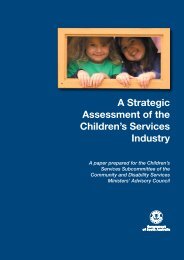Global Study On Child Poverty And Disparities (PDF) - Social Policy ...
Global Study On Child Poverty And Disparities (PDF) - Social Policy ...
Global Study On Child Poverty And Disparities (PDF) - Social Policy ...
You also want an ePaper? Increase the reach of your titles
YUMPU automatically turns print PDFs into web optimized ePapers that Google loves.
etween 2000 and 2007, but then rose to 7.5<br />
per cent of GDP in 2008. This was due largely to<br />
increased contributions from Australia as well as<br />
infrastructure funding by the United States through<br />
the Millennium Challenge Account.<br />
Figure 1.12: Composition of government<br />
revenues, Vanuatu, 2000 to 2008 (% of GDP)<br />
Source: VNSO, Ministry of Finance and Economic<br />
Development.<br />
Public spending<br />
Figure 1.13: Government expenditures on health<br />
and education in proportion to total government<br />
expenditure, 2000 to 2008 (% of total)<br />
0.0% 2000 2001 2002 2003 2004 2005 2006 2007 2008<br />
Health Education<br />
45.0%<br />
40.0%<br />
35.0%<br />
30.0%<br />
Taxes on Internal Trade and Transactions Non Tax Revenue<br />
25.0%<br />
Grants from Foreign Governments and International Organisations<br />
20.0%<br />
Royalties, Rents<br />
15.0%<br />
35.0%<br />
10.0%<br />
30.0%<br />
5.0%<br />
25.0%<br />
0.0% 2000 2001 2002 2003 2004 2005 2006 2007 2008<br />
20.0%<br />
15.0%<br />
Source: VNSO, Ministry of Finance and Economic<br />
10.0%<br />
Development.<br />
5.0%<br />
Public spending on health and education varies<br />
significantly across provinces (Table 1.5), with<br />
education spending ranging between VUV 18,700<br />
per child in Penama to close to VUV 28,000 per<br />
child in Shefa (which includes Port Vila).<br />
The Government of Vanuatu invests a large share<br />
of its resources in health and education (Figure<br />
1.13). In 2008, 21 per cent of total government<br />
expenditures went to education, representing<br />
6.0 per cent of GDP, while health spending was<br />
around 10 per cent of total expenditures and<br />
about 2.9 per cent of GDP. Spending on health<br />
and education as a percentage of GDP has<br />
increased by around 50 per cent since 2000.<br />
A notable challenge for the Government is the<br />
control of the public wage bill, which is much<br />
larger than in other PICs, even though the total<br />
share of public employment is similar. The IMF<br />
(2009) noted that wages constitute about half of<br />
recurrent government expenditures, and that the<br />
public wage bill increased from 10.5 per cent of<br />
GDP in 2005 to 12 per cent of GDP in 2008. By<br />
their nature, public health and education spending<br />
involve significant wage shares.<br />
Table 1.5: Health and education expenditures at the sub-national level, 2008<br />
Public health<br />
expenditures (VUV)<br />
Public education<br />
expenditures (VUV)<br />
<strong>Child</strong> population<br />
(0-17)<br />
Per capita health<br />
expenditure<br />
Per child education<br />
expenditure<br />
Torba 42,650,228 101,817,646 4,420 9,649 23,036<br />
Sanma 242,574,812 369,252,012 16,081 15,085 22,962<br />
Malampa 125,894,278 357,043,319 13,081 9,624 27,295<br />
Penama 95,891,050 280,191,144 15,059 6,368 18,606<br />
Shefa 395,498,700 658,290,480 23,559 16,788 27,942<br />
Tafea 111,542,128 328,193,525 15,786 7,066 20,790<br />
Vanuatu 1,568,899,324 3,527,378,682 87,986 17,831 40,090<br />
Notes: Total expenditure includes Official Development Assistance going through government accounts; health includes<br />
community health and provincial hospital funding only; education includes primary and secondary schools, provincial (education)<br />
office expenditure only. Education does not include certain primary school allocations (grants, teachers’ incidentals and stationery)<br />
and some secondary school teacher salaries, as these expenditures do not have a regional breakdown. Total education<br />
expenditure excludes the donor budget in 2008.<br />
28
















